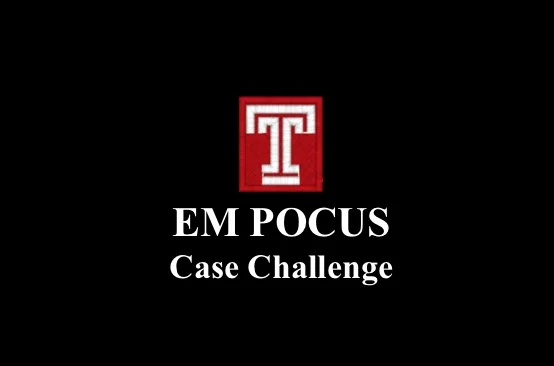Case:
A 26 yo female with history of hepatitis C and intravenous drug abuse presented to the ED with 6 months flu-like symptoms, including subjective fevers and chills, fatigue, poor nutritional intake and weight loss, associated with a cough productive of foul tasting green sputum. The patient had been seen at an outside hospital several days prior for the same symptoms, but left against medical advise when they wanted to admit her for antibiotics.
On exam, she was afebrile and hemodynamically stable. Her lung sounds were coarse throughout and diminished at the left base. A chest x-ray was obtained that was read as an elevated left hemidiaphragm with associated hiatal hernia and left sided pleural effusion. Noting the air-fluid level within the left chest and not feeling confident that a hiatal hernia was the source of this finding, a bedside ultrasound of the chest was performed and showed the following.
Case conclusion:
The ultrasound shows a hypoechoic collection that appears to have a thick wall and contained internal echos at the left lung base, concerning for intrapulmonary abscess.
The patient had a CT scan to further characterize the pulmonary collection and confirmed the findings of a pulmonary abscess with air-fluid level, as well as multiple bilateral consolidative nodules concerning for multifocal pneumonia versus septic emboli. She was treated with antibiotics and had an IR guided pigtail chest tube placed to drain the abscess. She underwent further work up for possible endocarditis as a source of the pulmonary abscess and was unlimitedly discharged on antibiotics.
Ultrasound pearls:
A lung abscess is the result of lung parenchymal necrosis secondary to a bacterial infection, compared to an empyema, which is an infection of the pleural space, commonly associated with pneumonia. The finding of a complex fluid collection at the lung periphery may represent either of these entities and differentiating the two can be challenging on ultrasound.
In general, pleural based abscesses can be seen as anechoic or hypoechic areas with a thick, irregular wall, frequently containing internal echos, and commonly take a rounded appearance. The brightly echogenic spots within the collection, known as the suspended microbubble sign (Chen), represent trapped air foci within the abscess, however this findings can be seen in gas containing empyemas as well. A more specific finding for intrapulmonary abscess is the presence of color Doppler signal within the consolidation immediately adjacent to the abscess.
Example from Chen at al illustrates the presence of vessel signal on doppler:
Emypemas are commonly seen as fusiform collections around the periphery of the lung with internal separations, but may also appear hypoechic and heterogenous, mimicking solid lesions. The internal separations, which appear in a weblike, breaching pattern within the effusion, can be seen in many transudative effusions, and are therefore not specific to empyema. Adjacent atalectatic lung is also a common finding associated with empyema and other large effusions.
Examples of empyemas include:
http://www.ultrasoundcases.info/Case-List.aspx?cat=458
http://www.ultrasoundcases.info/Case-List.aspx?cat=458
Given that accesses and emypemas may appear very similar ultrasonographically, CT imaging may still be necessary to differentiate the two modalities. The distinction is important clinically, as empyemas typically need to be drained, either with a thoracotomy tube or more invasive surgical procedure, where as lung abscesses will frequently resolve with antibiotic therapy alone.
-Allison Zanaboni, M.D., Emergency Ultrasound Fellow
References:
Desai H, Agrawal A. Pulmonary emergencies: pneumonia, acute respiratory distress syndrome, lung abscess, and empyema. Med Clin North Am. 2012;96(6):1127-48.
Koh DM, Burke S, Davies N, Padley S. Transthoracic US of the Chest: Clinical Uses and Applications. RadioGraphics. 2002; 22(1).
Chen HJ, Yu YH, Tu CY, et al. Ultrasound in peripheral pulmonary air-fluid lesions. Color Doppler imaging as an aid in differentiating empyema and abscess. Chest. 2009;135(6):1426-32.



